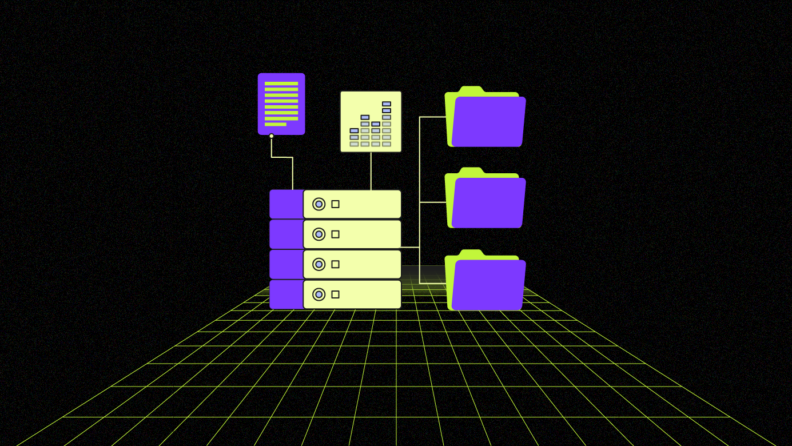Humans and machines produce more than 2.5 quintillion bytes of data daily. That’s 2.5, followed by a whopping 18 zeros. Better spring for your ISP’s unlimited data plan!
No matter how good you are at data collection, data has little value unless you can make sense of it. The goal isn’t to see who can fill up their hard drive first. It’s to use data to make informed decisions about your operations.
That’s why we’re singing the praises of data integration. We put together this guide to help you understand what data integration is and how it can help you create a single source of truth for your business.
What is Data Integration?
If you use multiple data sources, you need some way to keep everything organized. Otherwise, team members won’t be able to identify gaps in the marketplace, understand current trends, or make real-time decisions.
Data integration involves creating a single unified view from different sources of data. For example, the typical business may collect data from the following places:
- Customer relationship management (CRM) software
- Marketing surveys
- Enterprise resource planning (ERP) systems
- Human resource information systems (HRIS)
- Social media
- Government databases
Without data integration tools, reviewing various sources and determining how each dataset relates to the others is incredibly time-consuming. Just imagine how long it would take to comb through your CRM to determine if every customer who completed a survey had been entered into the system.
Data Silos
You also have to worry about data silos, which are data repositories controlled by small groups of people within your organization. Sure, those people can use the data to make business decisions, but no one else can. Think of a silo as a giant brick wall that prevents your employees from accessing relevant data and using it to increase operational efficiency.
A good data integration solution takes data from disparate sources and makes it available to everyone who needs it, making big data an asset to your organization instead of a burden.
Key Benefits of Data Integration
Business intelligence is a broad word that describes the activities involved in analyzing data and turning it into actionable information. Before establishing an effective BI program, you must find a way to extract data from different systems and make it available to key decision-makers. Data integration can help your business in the following ways:
1. Better Data Quality
Data quality describes how well a dataset meets your criteria for accuracy, consistency, and completeness. High-quality data helps you make decisions, while low-quality data leads you on wild goose chases.
For example, duplicate data is a problem because it prevents you from making accurate decisions. If you have three records for the same customer, you may count their annual spend three times, making it impossible to produce precise revenue estimates.
The proper data integration process eliminates duplicates and other data quality issues, giving you better datasets. As a result, your team members can make decisions with confidence.
2. Cost Savings
When you optimize your approach to data management, you eliminate redundancies and reduce your reliance on manual tasks. You also spend less on IT services, training, and other activities, making it easier to achieve your company’s financial goals.
For example, if you’re spending $50,000 per year on services related to collecting real-time data and making it accessible to team members, a 10% reduction in costs would save you $5,000. Thus, data integration makes it possible to increase your profit margin even if your revenue and other expenses stay the same.
3. Better Decision Making and Collaboration
When you make decisions with incomplete datasets, it’s like shooting at a target with a blindfold on. Sure, you might hit the target by accident, but that’s not the best way to do it.
Data integration allows you to combine data from multiple source systems in one place. It also improves the quality of your data analytics and reduces the need for manual data entry, leaving team members with more time to spend on strategic decision-making activities.
Before data integration platforms became widely available, many employees struggled to collaborate effectively.
4. Improved Efficiency
Streamlining business processes is one of the best ways to reduce waste and increase output. If you have a single source of truth for your business, team members don’t have to waste time accessing multiple systems or dealing with data in multiple formats. They can view a business dashboard or access custom reports, giving them more time for other activities.
5. Higher-Quality Customer Experiences
As an added bonus, data integration may lead to increased customer satisfaction. For example, if you can access plenty of relevant data, you can use it to map the customer journey. This makes it easier to determine the process a customer follows from the time they become aware of your brand to the time they make a purchase.
6. Increased Revenue Streams
Improving your ability to extract, transform, and analyze data also makes it possible to create new revenue streams. For example, some companies now monetize their data, increasing revenue without investing heavily in new resources.
Walmart is one of the best examples. Once it mastered everyday low prices, the retail giant started sharing data with suppliers. Its data product, Walmart Luminate, provides merchants valuable information about consumer behavior and channel performance, allowing them to make better decisions.
7. Increased Data Accessibility
Without data integration, it would be difficult for team members in your sales, marketing, and customer service to share accurate data. Now that CRM systems are available, employees in these departments can find out exactly what’s happening with customers and prospects anytime.
For example, if a customer service agent talks to 10 customers with the same complaint, they can record that data in your CRM system. The next time a sales professional reviews the data, they’ll be better equipped to overcome customer objections and set realistic expectations.
8. Stronger Data Security
Gaining a competitive advantage is one of the best reasons to use data integration, but it’s not the only reason. Data integration also protects your company from serious security risks.
For example, if you switch to an on-premises system, it’s easier to manage access to the data stored in your servers. You can set up role-based access, ensuring employees can’t access confidential data unrelated to their jobs. It’s also easier to create a detailed audit control using an integrated system rather than multiple data sources.
9. Seamless Data Sharing
Seamless data sharing is one of the most significant advantages of data integration. A “seamless” process allows team members to share, receive, and analyze data without going through cumbersome processes.
For example, your HR department has to share information with payroll, accounting, project management, and other teams. Without data integration, they’d have to spend much of their time making phone calls, writing emails, and searching through disparate systems to find valuable data.
Thanks to enterprise data integration, it’s possible for employees in other departments to access HR data, enabling them to make better decisions. If a project manager needs to know if they have enough labor resources to begin a new project, they can easily find the information on a business dashboard. Accounting can also monitor hiring trends to determine if payroll costs will increase or decrease.
10. Increased Agility
Agile businesses respond quickly to new opportunities in the marketplace, making them more successful. Data integration increases agility by ensuring that team members have access to real-time data. As a result, employees can make decisions based on what’s happening now, not what was happening 2 months ago when you ran your last report.
Here’s an example. Imagine that one of your closest competitors is going out of business without warning. If you have a unified view of your business data, you can quickly determine if you have the resources necessary to fill this new gap in the marketplace. Therefore, data integration also increases scalability.
11. Unified Data Governance
Data governance refers to your data collection, storage, processing, and retrieval policies. In addition to increasing competitiveness, data integration makes it easier to set these policies and ensure team members adhere to them. For example, you can easily create a policy related to the storage and retrieval of customer data.
Data Integration Strategies to Transform Operations
Manual Data Integration
Manual data integration involves having engineers write code to control the movement of data. It’s best for companies with only a few data sources to integrate.
Benefits
- Total control over the integration process
- Less expensive than other methods
Drawbacks
- Prone to errors
- Requires manual coding
Use Case
Manual integration would be ideal for a small bookkeeping company that needs to integrate data from a separate bookkeeping program into its accounting system.
API-Based Data Integration
API-based integration connects two or more apps via their application programming interfaces, which allows them to exchange data.
Benefits
- Automated
- Scales as you increase the amount of data in your system
- User-friendly option
- Simple data transfer between apps
Drawbacks
- Requires multiple applications
- Dependent on external APIs
- Requires skilled data managers to oversee the process
Use Case
API-based integration might be a good fit for a company already using multiple applications and needs a way to connect them all.
Data Virtualization
Data virtualization uses software to bridge multiple data sources, making it easier to create a unified view of your business. It’s especially helpful in dynamic market environments, giving you access to real-time data.
Data Warehousing
Data warehousing involves pulling data from multiple sources and storing it in a single repository. Like virtualization, data warehousing increases access to real-time data. It’s beneficial for companies in the healthcare industry, as it’s capable of combining lab results, pathology reports, prescription records, operative notes, and other health-related data sources.
Takeaways
Data integration can’t make millions of dollars appear out of thin air, but it can help you increase efficiency, identify new sources of revenue, and increase collaboration within your business.
Subscribe to The CTO Club newsletter for more industry news and discussions on data integration and other important topics.



